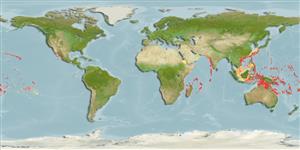>
Holocentriformes (Squirrelfishes, soldierfishes) >
Holocentridae (Squirrelfishes, soldierfishes) > Holocentrinae
Etymology: Neoniphon: Greek, neos = new + Greek, niphon = to snow (Ref. 45335).
Environment: milieu / climate zone / depth range / distribution range
पारिस्थितिकी
समुद्री प्रवाल-भित्ति संयुक्त; गहराई सीमा 30 - 188 m (Ref. 89972), usually 40 - 70 m (Ref. 4201). Tropical; 32°N - 24°S
Indo-Pacific: Mauritius, Reunion, and the Comoros to the Hawaiian and Marquesan islands, north to southern Japan, sourth to the Great Barrier Reef (Ref. 37816).
आकार / वज़न / Age
Maturity: Lm ? range ? - ? cm
Max length : 25.0 cm TL पुल्लिंग / अलिंग; (Ref. 9710)
पृष्ठीय रीढ़ (सम्पूर्ण) : 11; पृष्ठीय सौफट रेज़ (सम्पूर्ण) : 12 - 14; गुदा कांटा: 4; ऐनल सौफट रेज़: 8 - 9. Only species of Neoniphon that has yellow body stripes, 3.5 instead of 2.5 scale rows above the lateral line, and a last dorsal spine that is shorter than the second to the last one.
Benthopelagic in or near crevices or caves at 30-188 m (Ref. 58302); collected from 100-190 m (Ref, 117152). Confined to outer reef slopes (Ref. 1602). Rarely occurring in less than 40 m depth, in current prone areas (Ref. 48635). Solitary or in small groups (Ref 90102). Feeds on crustaceans (Ref. 89972).
Life cycle and mating behavior
Maturities | पुनरुत्पत्ति | Spawnings | Egg(s) | Fecundities | लार्वा
Randall, J.E. and C. Heemstra, 1985. A review of the squirrelfishes of the subfamily Holocentrinae from the western Indian Ocean and Red Sea. Ichthyol. Bull. J.L.B. Smith Inst. Ichthyol. (49):1-29. (Ref. 7459)
IUCN Red List Status (Ref. 130435)
Threat to humans
Harmless
Human uses
साधन
Special reports
Download XML
इंटरनेट स्रोत
Estimates based on models
Preferred temperature (Ref.
123201): 21.5 - 28.2, mean 27 °C (based on 122 cells).
Phylogenetic diversity index (Ref.
82804): PD
50 = 0.5312 [Uniqueness, from 0.5 = low to 2.0 = high].
Bayesian length-weight: a=0.01549 (0.00736 - 0.03261), b=2.97 (2.80 - 3.14), in cm total length, based on LWR estimates for this (Sub)family-body shape (Ref.
93245).
Trophic level (Ref.
69278): 4.0 ±0.66 se; based on food items.
लौटाव (Ref.
120179): ऊंचा, न्यूनतम जनसंख्या दुगनी समय अवलागत 15 महीने। (Preliminary K or Fecundity.).
Fishing Vulnerability (Ref.
59153): Low vulnerability (15 of 100).
Nutrients (Ref.
124155): Calcium = 58.4 [26.1, 197.9] mg/100g; Iron = 0.666 [0.277, 1.349] mg/100g; Protein = 18.7 [17.5, 19.9] %; Omega3 = 0.199 [0.080, 0.479] g/100g; Selenium = 42.2 [24.1, 83.2] μg/100g; VitaminA = 76.9 [29.8, 213.5] μg/100g; Zinc = 1.15 [0.74, 1.78] mg/100g (wet weight);
